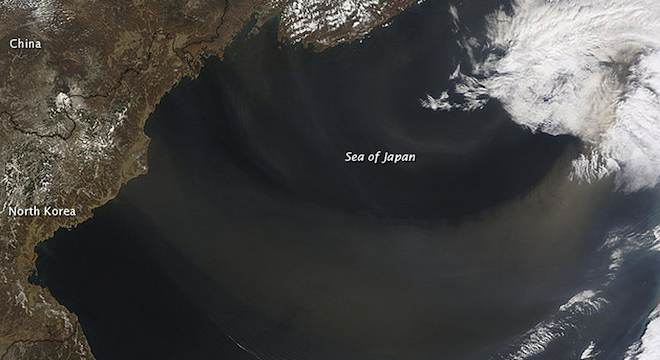A new study of satellite data by NASA and university scientists reveals for the first time the amount of airborne particles that float into North American atmosphere every year from other continents, as well as the composition of these particles and what it may mean for climate change.
An estimated 64 million tons of particulate matter, about half of the total amount currently floating high above North America, comes from overseas, according to the results of a new study of 3D views of the atmosphere obtained from NASA’s Terra satellite and the joint American–French CALIPSO satellite. The remaining 69 million tons of particulate matter comes from domestic sources, according to the analysis.
“The take-home message is that this is a small world and we share one atmosphere,” said Hongbin Yu, an atmospheric scientist at the University of Maryland who led the study, in a statement published on NASA’s website. “Every country is influencing other countries’ back yards.”
A satellite image of the type of particulate matter that makes its way over to the U.S., Canada and Mexico from countries like Mongolia appears at the top of this article. Other views and the results of the study are also featured in the following video from NASA’s Earth Science Division:
Specifically, Yu and his colleagues found that between 60 and 70 percent of the particulate matter that arrives in North America from foreign sources comes from Asia, and some 88 percent of it arrives by airborne currents over the Pacific Ocean.
On the plus side, most of the particulate matter observed turned out to be dust, not industrial pollution, and most of it was too high for humans to breathe, according to the study.
While that’s better for North Americans’ health in the short term, NASA points out that the “impact on climate can be significant,” though again, not in the way one might expect.
“Globally this can mask some of the warming we expect from greenhouse gases,” said Lorraine Remer, a University of Maryland atmospheric scientist and a co-author of the study, also in a statement on NASA’s website.
By the same token, “there are several other potential impacts that this study doesn’t address in detail,” admitted Yu in a Q-and-A on the results. “Dust and pollution aerosols can seed cloud and affect rainfall patterns.”
Also, the results of the study, published online on the journal Science‘s website on August 2, point out that “changes in meteorological conditions and potential desertification,” could increase the amount of dust and particulate matter in North America’s skies, even if pollution control measures are put in place.






